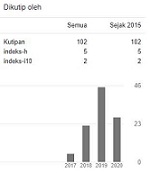AN ANALYSIS ON CODE SWITCHING AND CODE MIXING USED BY THE ENGLISH LECTURERS IN THE CLASSROOM INTERACTION
Abstract
As bilingual speakers the English lecturers give explanation and instruction by using their languages freely. They tend to switch code as well as mix code between two languages (Indonesian-English or vice versa) in order to create an effective strategy of communication in the classroom. This study described the forms of code switching applied in clause, tag, filler, interjection, and the forms of code mixing applied in word and phrase through Fasold and Holmes’ theory. The implementation of them was based on the position (as translation and without translation).
Keywords
References
Chaer, Abdul and Agustina Leoni, 2004. Sociolinguistic: Perkenalan Awal. Jakarta: PT Rineka Cipta.
Graddol, David, et al. 1997. English, History, Diversity and Change, New York/London: The Open University.
Iragiliati, Emalia and Refnaldi. 2007. Sociolinguistics, Jakarta: Universitas Terbuka
Moleong, Lexy. J. 2005. Metode Penelitian Kualitatif. Bandung: Remaja Karya CV.
Spolsky, Bernard. 1998. Sociolinguistics. New York: Oxford University Press.
Sy, Evha Nazalatus Sa’adiyah. 2013. An Analysis of Figurative Language in Doo-Woops and Hooligans As A Strategy In Improving Reading Comprehension. Interaksi 8 (no 1), 44-46, 2013.
Trudgill, Peter. 1974. Sociolinguistics: An Introduction. England: Pinguin Books. Ltd.
Wardough, Ronald. 2002. An Introduction to Sociolinguistics. USA: Blackwell Publisher Ltd.
DOI: 10.53712/ellite.v2i1.745
Refbacks
- There are currently no refbacks.







